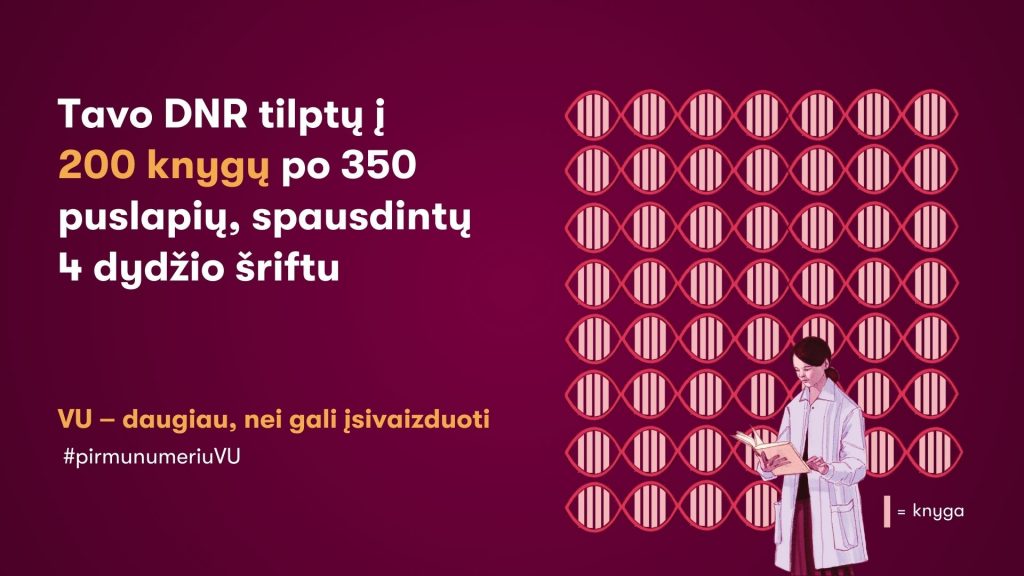Imagine that each person’s genetic information is like a library, where hundreds of carefully written books hold everything about who we are, from eye color to susceptibility to certain diseases. If even a single mistake slips into these books, it can lead to serious health problems. Correcting such errors was impossible for a long time, but that changed with the advent of gene-editing technology. The gene scissors discovered by Prof. Virginijus Šikšnys and his team at Vilnius University work like a precise editor, allowing scientists to correct DNA errors like editing text on a computer.
 |
| Prof. Virginijus Šikšnys. VU photo |
Interestingly, the technology that won the Nobel Prize in 2020 was discovered while seeking answers to entirely different scientific questions. This breakthrough emerged from research on how bacteria used in yogurt production defend themselves against viruses. Today, the technology is already being applied to treat genetic diseases, and researchers at Vilnius University continue to look for ways to make gene therapy faster, more affordable, and accessible to everyone. In the future, DNA editing might become as common a procedure as taking medicine or getting vaccinated.
Human DNA Would Fill up to 200 Books
When asked why science needed gene scissors, Prof. Virginijus Šikšnys explains that the answer lies within human DNA. DNA is like a blueprint of human life, encoding essential information about our appearance, health, predisposition to diseases, and even aspects of our personality.
“Our DNA is like a giant text composed of just four ‘letters’ – A, C, G, and T – arranged in extremely long sequences. For example, human DNA contains about 3 billion letters.
If this genetic code were printed in book form, it would take up about 200 books with 350 pages each,” says the scientist.
DNA, much like a computer program, functions flawlessly as long as there are no errors.
However, when mistakes occur – due to natural mutations or inherited genetic defects – the normal functioning of the human body can be disrupted, leading to genetic diseases.
“Imagine having this entire long DNA, a massive text – 200 books – and a single mistake appears. The question is: how do you find it? Flipping through page by page would take an enormous amount of time, and once the error is finally found, how do you correct it in a printed text?” the professor asks rhetorically.
Scientists had long been searching for ways to detect and correct such errors in the human genome, but until recently, they lacked the necessary tools.
 |
| Ūla Šveikauskaitė illustration |
Gene Scissors Discovered in a Yogurt Cup?
Prof. Virginijus Šikšnys shares that if someone had simply said "find a gene-editing tool," it would likely have been unclear where even to start looking. The most significant scientific discoveries often happen not by deliberately searching for something specific, but by trying to understand the world around us and seeking answers to broader scientific questions.
“This is exactly what happened here. Scientists were solving a problem faced by the dairy industry, where bacteria are used as essential tools for producing cheese and yogurt. Like all living things, these bacteria, just like humans, are attacked by deadly viruses. Imagine: if a virus suddenly infects the bacterial cultures used for industrial yogurt production, the bacteria die, yogurt production stops, and the entire batch must be discarded. Such a scenario would cause major financial losses, so scientists began looking for ways to protect the bacteria used in yogurt production against viruses,” explains the biochemist.
In 2007, during these investigations, French researchers discovered an interesting bacterial defense mechanism against viruses – CRISPR. They noticed that bacteria preserve fragments of viral DNA in their genome, and when attacked a second time, they recognize and destroy the invading virus.
“After reading about this research, the question arose - how exactly do bacteria do this? Could the same mechanism work in any other genome? So I wrote to the French scientists asking for bacterial samples to study them more thoroughly,” recalls Prof. Šikšnys.
Gene Scissors Work Like a Text Editing Program
When these bacteria arrived at Prof. Šikšnys’ laboratory at the Vilnius University Life Sciences Center, his team began to study their virus-defense (CRISPR) system. They discovered that in some cases, a single protein was responsible for protecting the bacteria from viruses.
“Our research revealed that bacteria use a special protein called Cas9 to defend themselves from viruses. It acts like gene ‘scissors’ - recognizing and cutting viral DNA, thus neutralizing the threat. This works because bacteria save a fragment of the virus’s DNA as a memory in their genome. Later, this fragment is converted into an RNA molecule, which binds to the Cas9 protein and guides it to recognize the invading virus’s DNA. Once guided, Cas9 cuts and destroys the viral DNA. This means that Cas9 can be ‘programmed’ using RNA: by changing the RNA sequence, Cas9 can be directed to a specific DNA site, including those where errors cause inherited genetic diseases. In this way, gene scissors can precisely edit genetic information, just like correcting mistakes in a document using a computer’s editing tool,” explains Prof. Šikšnys.
This research was described by VU scientists in 2012 in the journal Proceedings of the National Academy of Sciences of the United States of America. Their article showed that Cas9-mediated DNA cutting could be used for programmable genome editing, giving scientists unprecedented precision in editing DNA.
Who Discovered Gene Scissors First?
Gene scissors were discovered independently around the same time (in 2012) in at least two university laboratories worldwide. Naturally, this raised the question of who was first.
As Prof. Šikšnys explains, there isn't always a unanimous agreement regarding scientific priority. When scientists complete a study, they submit their manuscript to a scientific journal, which records the submission date. If the article is deemed significant, it is sent out for peer review. After responding to reviewers’ comments, the revised article is accepted, and the acceptance date is recorded, followed by the final publication date.
“Often, the date when the article is first submitted is considered the moment of priority because it marks when the research leaves the laboratory,” says Prof. Šikšnys.
However, some believe that the publication date is more important. Thus, the question of who exactly discovered gene scissors first remains open. The Vilnius University scientists' paper describing the gene scissors technology reached major scientific journals first, but it was published later than similar studies by the future Nobel Prize winners.
Approved Therapies for Treating Genetic Diseases
The gene scissors technology became one of the most important scientific breakthroughs of the past decade, reaching clinical practice in recent years. In the U.S., two therapies have been approved to treat sickle cell anemia and beta-thalassemia, two blood disorders caused by mutations in the hemoglobin gene.
“Modern gene therapies that are now in clinical use are usually based on so-called ex vivo therapy,” explains Prof. Šikšnys. “For example, when treating sickle cell anemia, stem cells are taken from a patient's bone marrow - the ones that produce red blood cells. In the lab, scientists correct the DNA error in these cells and then return the genetically modified cells to the patient's body.”
However, he notes that this process is currently complex, expensive, and time-consuming. The cells must be carefully removed, multiplied, genetically edited, and handled under controlled conditions to avoid infections or other complications.
"This entire treatment cycle can take about a month or even longer - but some patients with severe disease forms cannot afford to wait," says Prof. Šikšnys.
Therefore, ongoing efforts aim to make gene therapy faster and more accessible.
Beyond Cutting: Silencing and Activating Genes
Today, scientists are further enhancing gene scissors technology. They can not only cut and replace damaged DNA but also silence or activate specific genes. How does it work? For instance, in treating sickle cell anemia, scientists can activate a version of the hemoglobin gene that functions during infancy but is naturally silenced later in life.
“If the adult hemoglobin gene has a mutation, we can activate the fetal hemoglobin gene, which had been naturally turned off. This allows the body to produce functional, mutation-free hemoglobin, helping patients avoid disease symptoms. Such therapies are already being tested in clinics,” Prof. Šikšnys explains.
Gene "silencing" technology also temporarily stops the expression of specific genes. “If we want to temporarily turn off a gene, we can use a modified Cas9 protein that binds to the target DNA without cutting it, blocking the cell’s machinery from reading the faulty information. This way, we can fine-tune gene activity without making irreversible changes to the genome, reducing the risk of damaging healthy parts of DNA,” he adds.
How Is Gene Editing Technology Being Improved?
As Prof. Šikšnys explains, one approach scientists currently explore is delivering gene scissors directly to human tissues or organs and correcting DNA errors inside the body. This would allow diseases to be treated much faster and more cheaply. One of the biggest challenges, however, is ensuring that the gene-editing tools reach only the intended cells without affecting the entire organism.
“There are trillions of cells in the human body. If we want to correct an error, for example, in liver or heart muscle cells, we need to make sure that the tool doesn't reach other tissues,” explains Prof. Šikšnys. Currently, researchers are working on ways to precisely target gene-editing mechanisms to specific organ cells.
One potential solution involves methods similar to those used in RNA vaccines, where the active substance is packaged into particles that deliver it directly to the target organ. Another approach under investigation is using harmless adenoviruses to deliver the tools. However, adenoviruses are too small to carry the larger gene-editing machinery, so Vilnius University scientists are searching for smaller, more efficient alternatives.
“There are many Cas9-like proteins, and our team has already identified several variants that are about three times smaller than the conventional gene-editing tools,” says the professor.
In the future, gene therapy may become not only more precise but also more accessible. Currently, therapies based on gene-editing technologies are extremely expensive.
“But if we learn to edit genes directly inside the human body, gene therapy could become a routine medical procedure widely used in healthcare,” says Prof. Šikšnys.
